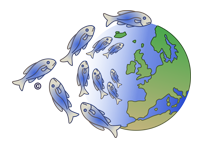

Pennatula phosphorea is a sea pen forming erect colonies of up to 40 cm tall. Swollen with water, they are fleshy and slightly bent over the surface. The bulbous stalk embedded in sediments is only visible in its upper part. Above the surface, a 25 cm tall rachis have numerous alternate opposite branches on each side of the central axis. They are triangular in cross-section in a leaf-like shape. Each branch has about fifteen autozooids regularly spaced, opening on the ventral side of the colony. Tiny siphonozooids are laid on each side of the central axis, in broad rows on the dorsal side, in narrower lines and extending a little between the branches on the ventral side. Colonies are retractile and may withdraw within the sediment or be more or less swollen above the surface. They are yellowish to pale pink with reddish shades due to deep blood-red sclerites concentration. When stimulated, the colony has a blue-green luminescence..
Pennatula phosphorea is found in muddy and sandy bottoms from 10 to at least 100 meters deep, in the North-East Atlantic, the North Sea and probably the English Channel and in the Mediterranean Sea.
Source : World Register of Marine Species
Biota (Superdomain)
Animalia (Kingdom)
Cnidaria (Phylum)
Anthozoa (Subphylum)
Octocorallia (Class)
Scleralcyonacea (Order)
Pennatuloidea (Superfamily)
Pennatulidae (Family)
Pennatula (Genus)
Pennatula phosphorea (Species)
Colony : group of several individuals of the same species. There, the colony has several individuals, the polyps, but the whole colony is considered as the animal.
Polyps : within these colonial animals, the polyp is the individual.
Rachis : upper part of the Pennatulacea bearing polyps.
Autozooids : specialized polyps in charge of catching food.
Siphonozooids : specialized polyps without tentacles in charge of driving water into the colony.
Sclerites : tiny calcareous elements forming a loose squeletal frame.
Text : Wilfried Bay-Nouailhat, Anne Bay-Nouailhat © 2008 - 2025.
Photos : ©
Mat Vestjens. Published with his kind permission.
Websites and reference works : Consult bibliography
Image satellite: © Esri, DigitalGlobe, GeoEye, Earthstar Geographics, CNES/Airbus DS, USDA, USGS, AeroGRID, IGN, and the GIS User Community.
Données de distribution : Pennatula phosphorea Linnaeus, 1758 in GBIF Secretariat (2019). GBIF Backbone Taxonomy. Checklist dataset https://doi.org/10.15468/39omei accessed via GBIF.org on 2025-12-07.
Source : World Register of Marine Species
Biota (Superdomain)
Animalia (Kingdom)
Cnidaria (Phylum)
Anthozoa (Subphylum)
Octocorallia (Class)
Scleralcyonacea (Order)
Pennatuloidea (Superfamily)
Pennatulidae (Family)
Pennatula (Genus)
Pennatula phosphorea (Species)
Colony : group of several individuals of the same species. There, the colony has several individuals, the polyps, but the whole colony is considered as the animal.
Polyps : within these colonial animals, the polyp is the individual.
Rachis : upper part of the Pennatulacea bearing polyps.
Autozooids : specialized polyps in charge of catching food.
Siphonozooids : specialized polyps without tentacles in charge of driving water into the colony.
Sclerites : tiny calcareous elements forming a loose squeletal frame.
Text : Wilfried Bay-Nouailhat, Anne Bay-Nouailhat © 2008 - 2025.
Photos : ©
Mat Vestjens. Published with his kind permission.
Websites and reference works : Consult bibliography
Bay-Nouailhat W., Bay-Nouailhat A., August 2008, Description of Pennatula phosphorea, [On line] https://european-marine-life.org/05/pennatula-phosphorea.php, consulted on 2025 December 07.
Authors

Plongeur - Naturaliste
Photographe Sous-Marin

Chargée d’études en environnement marin
Plongeuse professionnelle - Naturaliste
© Mer et littoral 2004-2025 - All rights reserved
The texts and images on this website are not free of rights and cannot be copied and/or used without the agreement of their respective authors.